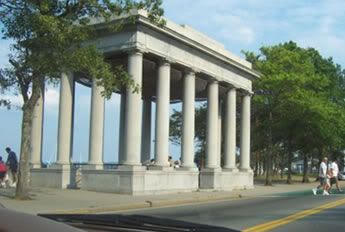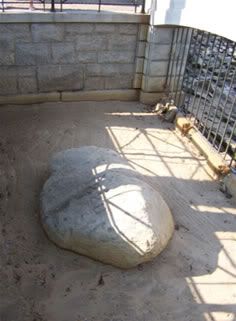
Ah, the great American Road Trip. Ever since weary trappers paddled inland searching for valuable rodents people have written about travelling in the USA. It's a bit easier these days of course. This is your author somewhere on Cape Cod with a typical New England wooden building in the background, as Lisa and I drove along the Massachusetts coastal highway from Boston. I was also closer than I appear, apparently.

Years ago I remember watching a series of documentaries recorded by someone who drove around the US filming out of his van window at various random things he passed. I can't remember anything about it, other than the jerky, off-coloured, cinefilm gave an interesting snapshot of countryside life and people going about their business. This is my version, and here we have a woodland glade with a man teaching his son how to fish. Or maybe shoving him in, who knows.

Churches are a big part of American lives, and this is a fairly typical New England example. It was another corking day, being near the sea kept the humidity down. We drove out to a beach on the inshore side of the cape - on a map the peninsula looks remarkably like a curled arm, so we made for the bicep and hit the coast. A long wooden boardwalk snaked out over a saltmarsh humming with insects and birds. Young kids clustered around a small bridge, taking turns to leap in to the salty water out of the heat.

In recent times, social commentators have mentioned the increasing remit of the law in the United States. Here we have a good example - in the NorthEastern states crack teams of policemen patrol the highways looking at drivers' lunches, mayonnaise cannons at the ready. Woe betide the casual motorist who gets caught mixing beef and salad cream. Relentlessly hunting down crimes against paninis, rolls, and baguettes, trained sniffer dogs stand rigid with attention if they detect two-day old lettuce in a bun, or cucumber situated next to the top slice of bread, causing unacceptable soggyness. These guys are so tough, they can believe it's not butter.

Here we have what looks like half an ancient Greek temple erected by the side of the road. This curious sight, and dozens of tourists, mean you have arrived in Plymouth (or Ye Olde Plimouth Plantation as I refuse to call it). This small coastal town is widely regarded as the point at which the original pilgrims landed in the New World, so of course is a major landmark in American history. However, as with a lot of things to do with history, the real story is slightly different to the oft-quoted one. The Pilgrims didn't step out onto a rock at Plymouth, but first landed at Provincetown at the end of the Cape (they might struggle to recognise it today). Also, when they landed at Plymouth, there was no rock - "On Munday they sounded ye harbor and found it fitt for shipping; and marched into ye land, & found diverse cornfields, & little running brooks, a place fitt for situation..." wrote Gov Bradford, who was in charge. Note there's no mention of any stone-based contact.

The first reference to the rock - and here it is - wasn't for 100 years after they arrived. The rock - described by some as the 'Most disappointing American landmark' (according to Wikipedia) has had a torrid history. In 1774 the townsfolk attempted to move it, under the leadership of the wonderfully named Colonel Theophilus Cotton. Sadly, the rock cracked in half - so they decided to move the top half and leave the rest where it was. The top was housed in an ornate monument at the top of the town. In 1880, the halves were reunited after a fancy backdrop was created by the water, and the date 1620 carved into the rock. Today less than 1/3 of the original sacred boulder survives, and the crack was repaired in 1989 (with cheap cement, by the look of it). For all the ceremonial pagentry, and historical importance, when you get there and lean over the ornate railing...well, it's a rock.